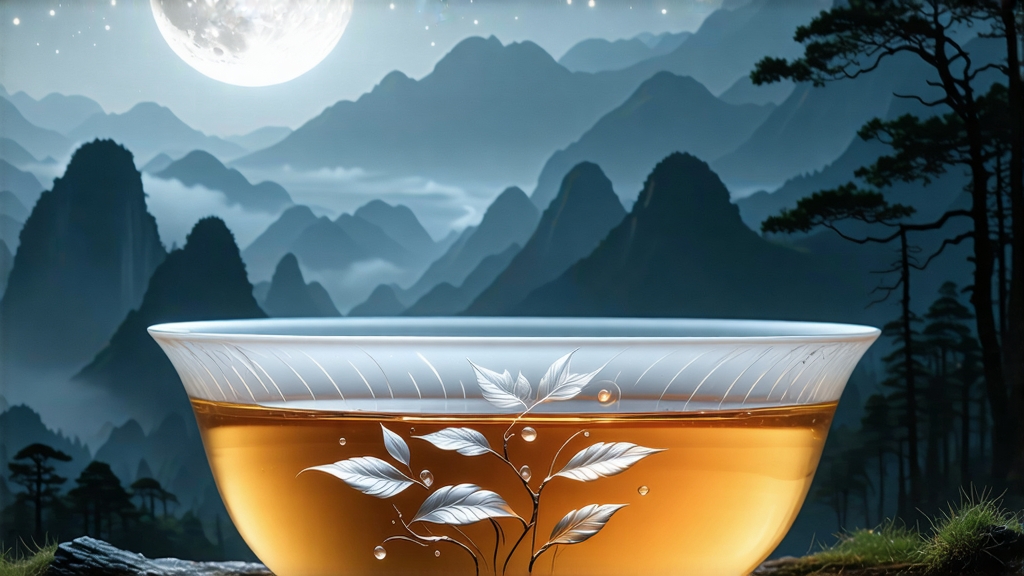
Tucked high on the forested ridges of Yunnan’s Simao and Lincang prefectures, where the Mekong carves silver ribbons through morning mist, a tea that has never seen the sun quietly absorbs lunar radiance. Locals call it Yue Guang Bai—Moonlight White—because, as legend insists, the leaves are plucked under the full moon and allowed to wither while bathed only in reflected light. The story is half poetry, half practicality: night plucking keeps the leaf temperature low, preserving the jade-white hairs that give white tea its name, while the cool air slows oxidation so subtly that the tea occupies a liminal zone between white and raw pu-erh. Whatever the science, every sip tastes like drinking moonlight distilled into liquid silk.
Historical whispers place Yue Guang Bai’s birth in the late 1990s, when Yunnan growers—already famous for dian hong black tea and sheng pu-erh—began experimenting with the Fujian white technique of “two withers and one bake.” They substituted local large-leaf Assamica cultivars, sun-dried by day on elevated bamboo trays, then moved indoors to continue withering under moonlight and low-watt bulbs. The hybrid process created a tea that carries the honeyed heft of Yunnan leaf yet retains the feather-light aromatics of Fujian white. By 2003 small batches appeared at Kunming tea markets; within a decade Moonlight White had become the darling of specialty cafés from Berlin to Melbourne, prized for both its approachable sweetness and its ability to age like a pu-erh, deepening in complexity for at least eight years.
Unlike the classic trinity of Fujian white teas—Silver Needle, White Peony, and Shou Mei—Yue Guang Bai is not yet codified into grades by China’s national standard. Still, connoisseurs recognize three informal styles. “Silver Moon” consists only of the single bud, downy and crescent-shaped, plucked in early March when nights remain chilly; the liquor is the color of pale chardonnay, with notes of lychee and fresh alfalfa. “Moonlight Peony” keeps one bud plus the first two leaves, yielding a thicker body and a fragrance that oscillates between dried apricot and white orchid. Finally, “Midnight Shou” uses larger leaves harvested in late April; pressed into 100-gram mini cakes, it develops cocoa and cedar after two years of natural aging in Yunnan’s dry highland climate.
Crafting Moonlight White is a choreography of restraint. Picking begins at 9 p.m. when leaf turgor is highest and field temperatures hover around 14 °C. Baskets are woven from bamboo strips too wide to bruise the bud; anything denser would trap heat and trigger premature oxidation. Back at the farmhouse, leaves are spread no thicker than two centimeters on mesh trays elevated one meter above the ground so air can circulate top and bottom. For the next 36 to 48 hours the tea master becomes a night watchman, adjusting humidity by opening or closing louvered windows, flipping the leaves every three hours with a feather-light touch. No shaking, no rolling—only the whisper of air and the slow retreat of moisture. At dawn on the third day, when the leaf feels like parchment and the stem snaps cleanly, a gentle bake at 45 °C for twenty minutes halts enzymatic activity without caramelizing sugars. The result is a leaf that is bi-colored: one side silvery white, the other charcoal black, as though the moon kissed only half its face.
Brewing Moonlight White is an exercise in minimalist precision. Begin with mountain spring water whose total dissolved solids sit between 30 and 80 ppm; anything harder flattens the tea’s ethereal top notes. Pre-warm a 150 ml gaiwan or glass teapot, then add 4 grams of leaf—roughly two heaping tablespoons of the peony style. The first infusion, at 85 °C for 25 seconds, is a “wake-up rinse” poured off immediately; it opens the leaf and primes the palate. The second steep, still 85 °C but extended to 45 seconds, releases a liquor the color of liquid topaz. Bring the cup to your nose: aromas of honeydew, starfruit, and a faint trace of pine pollen drift upward. Sip slowly, letting